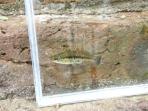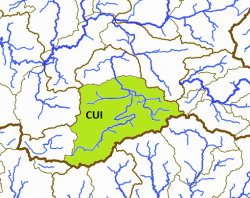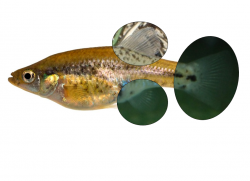Xenotoca cf. variata
This species was already described as part of a thesis (Domínguez-Domínguez et al., 2008), but this doesn't qualify as officially published due to Mexican law, therefore it still counts as an undescribed species.
undescribed species
undescribed species
undescribed species
The genus Xenotoca was erected for Characodon variatus by Hubbs and Turner in Turner, 1937, because "this species differs from Characodon (lateralis) in numerous internal as well as external features. Characters distinguishing Xenotoca from Characodon involve the ovarian anatomy, the form and structure of the trophotaeniae, and some superficial features". The generic name can be derived from the ancient Greek with the word ξένος (xénos) meaning strange and and τόκος (tókos) offspring. Xenotoca can therefore be translated with "a strange type of offspring".
undescribed species
The Lake Cuitzeo Jeweled Splitfin is endemic to the Mexican federal states of Michoacán and Guanajuato. It occurs exclusively in the endorheic Río Grande de Morelia basin (including the Lago Cuitzeo and the Presa Cointzio) and several springs in this basin like the manatinales La Maiza, San Cristobal and La Mintzita, as well as the springs in Zinapécuaro and Huingo. No subpopulations are distinguished. The bold names are the ones officially used by the Instituto Nacional de Estadística y Geografía; nevertheless, other ones might be more often in use or better known and therefore prefered.
ESU ist short for Evolutionarily Significant Unit. Each unit expresses an isolated population with different genetic characteristics within one species. ESU's can be defined by Molecular genetics, Morphology and/or Zoogeography and help in indicating different phylogenetic lineages within a species. The abbreviation for an ESU is composed of three letters of the genus, followed by the first two letters of the species name and an ongoing number in each species.
In Xenotoca cf. variata we are not able to distinguish any ESU. As the species is still ranked as Xenotoca variata, the corresponding abbreviation is Xenva5.
The left map shows the Lago de Pátzcuaro-Cuitzeo y Lago de Yuriria basin from the Hydrographic Region Lerma-Santiago on a Mexico Map, the right map the Lago de Cuitzeo subbasin (CUI). A channel connects this subbasin theoretically with the Laguna de Yuriría subbasin, but it was opened just one time within the last decades. The species seems to have not reached the Yuriría lagoon or when it did, it was not able to establish there. Also no hybrids with Xenotoca variata were found:
International Union for Conservation of Nature (IUCN): not assessed (undescribed species)
Distribution and current conservation status of the Mexican Goodeidae (Lyons et al., 2019): Least Concern/declining (including Xenotoca variata): „This species is broadly distributed in central Mexico throughout the Lerma and upper Santiago river basins on the Pacific slope, the endorheic Lake Cuitzeo/Grande de Morelia River basin in central Mexico, and a small area of the upper Pánuco River basin on the Atlantic slope (Miller et al., 2005). It reaches a relatively large total length (~100 mm) and is caught and eaten in Zacapu Lake, Michoacán. It is highly tolerant of pollution and habitat modifications and, along with Goodea atripinnis, still persists in areas where other goodeid species have been eliminated. Xenotoca variata is currently found at many locations throughout its historic range. Nonetheless, the species has declined in recent years, disappearing from heavily polluted areas of the Santiago and Lerma basins and from reservoir and lake habitats where the non-native Micropterus salmoides (Centrarchidae) has become established (Lyons et al., 1998; Soto-Galera et al., 1998, 1999; Domínguez-Domínguez et al., 2005; Mercado-Silva et al., 2006). We recognize five ESUs based on genetic analyses (Domínguez-Domínguez et al., 2010). Xenva1 is classified as least concern and broadly distributed in the Santiago, Lerma, and Pánuco basins. Many populations are still present, but others have disappeared from the Lerma River and its major tributaries due to water pollution. Xenva2 is vulnerable and known from a single location, Lake Los Negritos (also known as La Alberca). The population there remains moderately large but appears to have declined because of non-native species. Xenva3 is vulnerable and found in the Angulo River drainage in the middle Lerma River basin. It has declined in abundance in the river but remains relatively common in the headwaters at Lake Zacapu. Xenva4 is vulnerable and known from the endorheic Aquanaval River basin. It has declined because of overuse of water and habitat loss. Xenva5 is least concern and found in Lake Cuitzeo and the Grande de Morelia River basin. It has declined in the lake proper owing to habitat loss and poor water quality and has been eliminated from the Grande de Morelia River near the city of Morelia, but still remains common at several locations. This last ESU is particularly distinctive genetically and may eventually be described as a separate species.“
NOM-059-SEMARNAT-2010: no categoría de riesgo (no category of risk)
This species is known from the Cuitzeo lake, where it can be found in murky water in the open and close to the shore near reed over sand, gravel and mud. Other habitats are springs like La Mintzita or San Cristobal that show clear water with lots of submerse vegetation (Nymphaea, Ceratophyllum) and algae on rocks, where the fish are permanently looking for food. Like nearly all Goodeids, this species prefers shallow water with depths less than 1m. On several surveys of the GWG to the Cuitzeo lake (2014, 2015, 2017) and La Mintzita spring (2014, 2015), the species was found in good numbers.
Underwater-Videos:
On a survey of the GWG to the Cuitzeo lake in November 2014, young fish with sizes from about 1.5cm standard length were found, so the Lake Cuitzeo Jeweled Splitfin reproduces probably by the end of the rainy season, but at least from September to October or November.
This species has probably the same feeding habits like its congener Xenotoca variata, means it is omnivorous with a preference for carnivorous food.
The Lake Cuitzeo Jeweled Splitfin is very similar coloured to the original Jeweled Splitfin, but without these striking yellow or orange colours some populations of that species may display. The species from the Río Grande de Morelia drainage is more silvery-whitish with less shiny scales than most of the populations of its congener. Both sexes have a lot of black blotches arranged in a midline and several dots and blotches on back and belly, with the size on the back being smaller and the number less numerous. Like Xenotoca variata, males have a yellow terminal band in the Caudal fin, followed by a dark grey zone which is usually separated from the yellow by a black line or band. The back might get a bit brownish in males while the belly stays white or whitish.
Males and females of the Lake Cuitzeo Jeweled Splitfin are quite easy to distinguish. The safest characteristic is the Splitfin in males, means the for Goodeinae typical mating organ formed by a notch after the first seven shortened rays of the Anal fin. Additionally, male Xenotoca cf. variata have a much bigger Dorsal fin than females. A third, but not so distinct character is the colouration with the males having a yellow terminal band on the caudal fin followed by a black band, while females always have clear fins. Usually males are a bit more intensively coloured than females, but this is not a safe character.
This species differs in some meristic characters and a number of nucleotid sequences from its close congener Xenotoca variata with the population from the Río Angulo being the closest one. This and a similar distribution and relationship of several other Goodeid species like Hubbsina turneri, Alloophorus robustus, Skiffia lermae and Zoogoneticus quitzeoensis suggest a historical connection between these two drainages. It belongs to the most abundant fish species in the Río Grande de Morelia basin.
For several years, this species was called Chapalichthys sp. "La Mintzita" by aquarists, pobably because its Dorsal fin is a bit bigger than the one of Xenotoca variata and therefore might have reminded some authors of a representative of this genus. However, it was always treated as a population of the Jeweled Splitfin by scientists, nevertheless, this dedication caused some confusion.
Looking on the biotopes of Xenotoca cf. variata, they suggest the species may prefer a habitat with moderate to swift current, structured with rocks, roots and small areas with dense submerse vegetation. Intraspecific aggession is sometimes observed, mostly between males of same size. Fry is sometimes eaten, but it may depend on the quantity and quality of food and on the number of places to hide. When several different stages of juveniles occur, fry may be neglected, so it makes sense to add separate brought up fry to the group with a size of 2 to 2.5cm to provide these stages and get a flock breeding colony.
The recommended tank size is at least 150 liters, bigger tanks with a generous base and little height (25cm are enough) are better for sure. A bit with roots and/or rocks structured tanks with few patches of dense submerse vegetation in the corners and bigger free areas to swim seem to do best with this species. The current should be moderate, especially as the oxygene level should be quite high (at least 8mg/l).
In the wild, adults of this species feed mainly from Crustaceans, worms and insect larvae, partly also from algae and aufwuchs, so much light to help algae grow and feeding with vegetables and additionally fiber-rich middle sized food from animalistic sources will be best for this fish. In aquarium, it feeds very well from flake food, granulate and tablets, additionally freeze dried food like Brine Shrimps is eaten greedy. The species is anything else but shy.
Concerning water quality, this species is in need of bigger water changes (60-80% every week) like most of the Goodeids, especially spring and river inhabiting species. Therefore an automatic water changing system can be helpful. Otherwise, in combination with constant temperatures higher than 25°C, fish may get sick, lose resistance against diseases and age too fast. So for keeping the strain healthy and strong, give the fish a rest during winter time with temperatures lower than 20°C for 2 or 3 months so they stop producing fry. In spring, when the temperature slowly increases, they will start spawning at 20 or 21°C and won't stop until it gets colder again or when it gets too warm (25°C).
This species does very well when is kept in the open from spring to fall, starting when the water temperature by day exceeds 15°C and cold periods are no longer expected. Bring them out in the early afternoon, the time of the day with the highest water temperature. During the warm summer, reproduction will stop and may occur again in fall. Bring the fish in before the water temperature deceeds 15°C by day and keep them cool for the first days, then slowly raise the temperature but try to stay below 20°C over the winter time.
Here each species are assigned populations of fish in husbandry and in brackets aliases of these locations to assist in identifying own stocks. Each population is assigned a unique Population-ID, composed by the ESU, the subbasin where this population is occurring (three capital letters) and a unique location identifier.
Populations in holding:
1. Xenva5-CUI-LCui
Population: Lago de Cuitzeo (aka Cuitzeo lake)
Hydrographic region: Lerma-Santiago
Basin: Lago de Pátzcuaro-Cuitzeo y Laguna de Yuriria
Subbasin: Lago de Cuitzeo
Locality: S coast of the Cuitzeo lake at the dam
2. Xenva5-CUI-LMin
Population: La Mintzita (aka La Mintzita spring, Manantial La Mintzita, Chapalichthys sp. "La Mintzita")
Hydrographic region: Lerma-Santiago
Basin: Lago de Pátzcuaro-Cuitzeo y Laguna de Yuriria
Subbasin: Lago de Cuitzeo
Locality: Manantial La Mintzita, about 5km SW of Morelia










